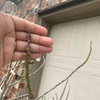Kaempferia rotunda - Fragrant? (Peacock Ginger/Asian Crocus)
mattdiclemente
13 years ago
More Discussions
Kaempferia rotunda, also known as one of the Peacock gingers, Resurrection ginger, or Asian Crocus, is a plant I have been excited about for years. Having read about them, I never understood what really attractive foliage the have. After seeing pictures of them for the first time online, I am certain I have actually seen them as foliage gift plants for sale in supermarkets many times before. How many must be thown away when they go into dormancy and their the recipients, assuming they are some sort of prayer plant (calathea) imagine them to be dead. Far from this though, in early spring, before the foliage unfurls, they will produce stemless purple and white flowers, at soil level.
What has drawn me to this plant for so long is the reported fragrance - lily, pure and carrying. But is Kaempferia rotunda in fact fragrant? I finally broke down and purchased one Kaempferia rotunda and one K. rotunda "Raven" yesterday from Gingerwood Nursery, and in spring 2011, with any luck, we shall see. Everyone seems to think so, most importantly the Fragrant Plant Maven, H.V.P.W., although I have heard a few opinions to the contrary. Significantly, Dave Skinner of GingersRus.com
writes that while Kaempferia rotunda is invariably described as a plant with fragrance, he has never been able to detect any.
What do you think? Some help from the school of first hand experience would be greatly appreciated. Do you grow Kaempferia rotunda, and are the spring flowers fragrant?
Best wishes,
Matt Di Clemente

Ispahan Zone6a Chicago
jimshy
Related Professionals
Elwood Landscape Architects & Landscape Designers · Palm Springs Landscape Architects & Landscape Designers · Gainesville Landscape Contractors · Wakefield Landscape Contractors · Berwyn Landscape Contractors · Commack Landscape Contractors · East Haven Landscape Contractors · Milton Landscape Contractors · Soddy Daisy Landscape Contractors · Sugar Hill Landscape Contractors · Maple Heights Landscape Contractors · Clearfield Landscape Contractors · Harvey Swimming Pool Builders · Lake Forest Swimming Pool Builders · Lincoln Swimming Pool BuildersmattdiclementeOriginal Author
mattdiclementeOriginal Author
mattdiclementeOriginal Author
costaricafinca
Anil Datt